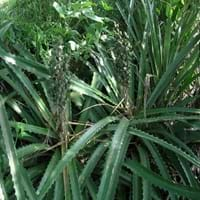Life Span
Perennial
Annual and Perennial
Type
Bulb or Corm or Tuber
Tender Perennial
Origin
South America, Argentina
North America, Mexico, Latin America and the Caribbean, Caribbean, Central America, South America
Types
Not Available
Bromelia agavifolia, Bromelia alsodes, Bromelia alta
Habitat
Temperate Regions
Hills, Lowland, Rocky areas, Thickets
USDA Hardiness Zone
5-9
Not Available
AHS Heat Zone
9-1
Not Available
Sunset Zone
21,22
Not Available
Habit
Clump-Forming
Not Available
Flower Color
Light Blue, Light Purple, Silver, Sky Blue
Not Available
Flower Color Modifier
Bicolor
Bicolor
Fruit Color
Not Available
Not Available
Leaf Color in Spring
Green, Light Green, Gray Green
Not Available
Leaf Color in Summer
Light Green
Not Available
Leaf Color in Fall
Several shades of Green
Not Available
Leaf Color in Winter
Light Green
Light Green
Leaf Shape
Grass like
Long Linear
Plant Season
Spring
Spring, Summer, Fall, Winter
Sunlight
Full Sun, Partial Sun, Partial shade
Not Available
Growth Rate
Medium
Not Available
Type of Soil
Clay, Loam, Sand
Not Available
The pH of Soil
Acidic, Neutral, Alkaline
Not Available
Soil Drainage
Well drained
Not Available
Bloom Time
Early Spring, Spring, Late Winter
Not Available
Repeat Bloomer
No
Not Available
Tolerances
Drought
Drought
Where to Plant?
Container, Ground
Container, Ground, Pot
How to Plant?
By dividing rhizomes, tubers
Seedlings
Plant Maintenance
Medium
Medium
Watering Requirements
Average Water Needs, Do Not over Water, Requires regular watering
Average Water Needs, Do Not over Water, Requires regular watering, Water Deeply
In Summer
Lots of watering
Lots of watering
In Spring
Moderate
Moderate
In Winter
Average Water
Average Water
Soil pH
Acidic, Neutral, Alkaline
Not Available
Soil Type
Clay, Loam, Sand
Not Available
Soil Drainage Capacity
Well drained
Not Available
Sun Exposure
Full Sun, Partial Sun, Partial shade
Not Available
Pruning
Remove damaged leaves, Remove dead branches, Remove dead leaves
Cut or pinch the stems, Remove damaged leaves, Remove dead branches, Remove dead leaves, Remove dead or diseased plant parts, Remove deadheads
Fertilizers
All-Purpose Liquid Fertilizer
Apply N-P-K, fertilize in fall, fertilize in growing season, fertilize in spring
Pests and Diseases
Slugs, Snails
Red blotch
Plant Tolerance
Drought
Drought
Flower Petal Number
Single
Not Available
Showy Fruit
No
Not Available
Edible Fruit
No
Not Available
Fragrant Flower
Yes
Not Available
Fragrant Fruit
No
Not Available
Fragrant Leaf
Yes
Not Available
Fragrant Bark/Stem
No
Not Available
Showy Foliage
No
Not Available
Showy Bark
No
Not Available
Foliage Texture
Medium
Not Available
Foliage Sheen
Matte
Not Available
Self-Sowing
Yes
Not Available
Attracts
Bees, Birds, Hummingbirds
Butterflies
Allergy
Not Available
Scratches, Skin cuts
Aesthetic Uses
Showy Purposes
Showy Purposes
Beauty Benefits
Not Available
Skin Problems
Environmental Uses
Air purification
Air purification
Medicinal Uses
No Medicinal Use
Not Available
Part of Plant Used
Flowers
Fruits, Leaves
Other Uses
Not Available
Cordage, ropes, Fibre
Used As Indoor Plant
Yes
Insignificant
Used As Outdoor Plant
Yes
Yes
Garden Design
Container, Lawns and Turf, Mixed Border, Rock Garden / Wall, Wildflower
Not Available
Botanical Name
Ipheion uniflorum
BROMELIA pinguin
Common Name
Spring Starflower, Springstar
Heart-of-Flame, Maya, Pinuela
In Hindi
Spring Starflower
bromelia pinguin plant
In German
Frühling Borretsch
Bromelia Pinguin -Anlage
In French
Spring Starflower
plante Bromelia Pinguin
In Spanish
primavera Flor de estrella
planta Bromelia Pinguin
In Greek
άνοιξη starflower
φυτό Bromelia Pinguin
In Portuguese
primavera Starflower
planta Caraguatá
In Polish
Wiosna Starflower
Bromelia Pinguin roślin
In Latin
Spring Starflower
Commelina pinguin herba
Phylum
Magnoliophyta
Magnoliophyta
Class
Lilopsida
Liliopsida
Order
Asparagales
Bromeliales
Family
Liliaceae
Bromeliaceae
Clade
Angiosperms, Monocots
Angiosperms, Commelinids, Monocots
Tribe
Gilliesieae
Not Available
Subfamily
Allioideae
Bromelioideae
Number of Species
Not Available
Not Available
Properties of Spring Starflower and Bromelia Pinguin
Wondering what are the properties of Spring Starflower and Bromelia Pinguin? We provide you with everything About Spring Starflower and Bromelia Pinguin. Spring Starflower doesn't have thorns and Bromelia Pinguin doesn't have thorns. Also Spring Starflower does not have fragrant flowers. Spring Starflower has allergic reactions like Not Available and Bromelia Pinguin has allergic reactions like Not Available. Compare all the properties and characteristics of these two plants. Find out which of these plant can be used as indoor plant. If you are interested to decorate your house and garden, find out aesthetic uses, compare them and select the plant which will beautify your surrounding. Along with beautification, try comparing medicinal and edible uses of Spring Starflower and Bromelia Pinguin and you can choose the plant having best and most benefits.
Season and Care of Spring Starflower and Bromelia Pinguin
Season and care of Spring Starflower and Bromelia Pinguin is important to know. While considering everything about Spring Starflower and Bromelia Pinguin Care, growing season is an essential factor. Spring Starflower season is Spring and Bromelia Pinguin season is Spring. The type of soil for Spring Starflower is Clay, Loam, Sand and for Bromelia Pinguin is Not Available while the PH of soil for Spring Starflower is Acidic, Neutral, Alkaline and for Bromelia Pinguin is Not Available.
Spring Starflower and Bromelia Pinguin Physical Information
Spring Starflower and Bromelia Pinguin physical information is very important for comparison. Spring Starflower height is 10.20 cm and width 5.10 cm whereas Bromelia Pinguin height is 100.00 cm and width 2.54 cm. The color specification of Spring Starflower and Bromelia Pinguin are as follows:
Spring Starflower flower color: Light Blue, Light Purple, Silver and Sky Blue
Spring Starflower leaf color: Green, Light Green and Gray Green
Bromelia Pinguin flower color: Not Available
- Bromelia Pinguin leaf color: Not Available
Care of Spring Starflower and Bromelia Pinguin
Care of Spring Starflower and Bromelia Pinguin include pruning, fertilizers, watering etc. Spring Starflower pruning is done Remove damaged leaves, Remove dead branches and Remove dead leaves and Bromelia Pinguin pruning is done Cut or pinch the stems, Remove damaged leaves, Remove dead branches, Remove dead leaves, Remove dead or diseased plant parts and Remove deadheads. In summer Spring Starflower needs Lots of watering and in winter, it needs Average Water. Whereas, in summer Bromelia Pinguin needs Lots of watering and in winter, it needs Average Water.





